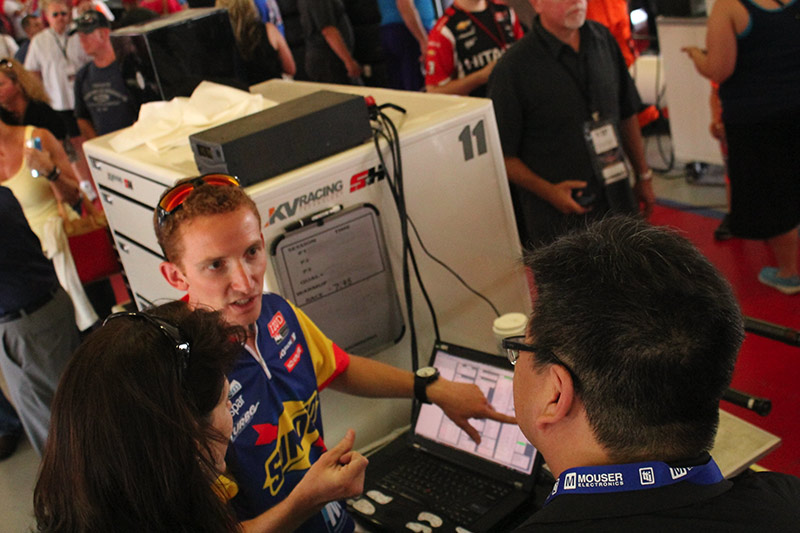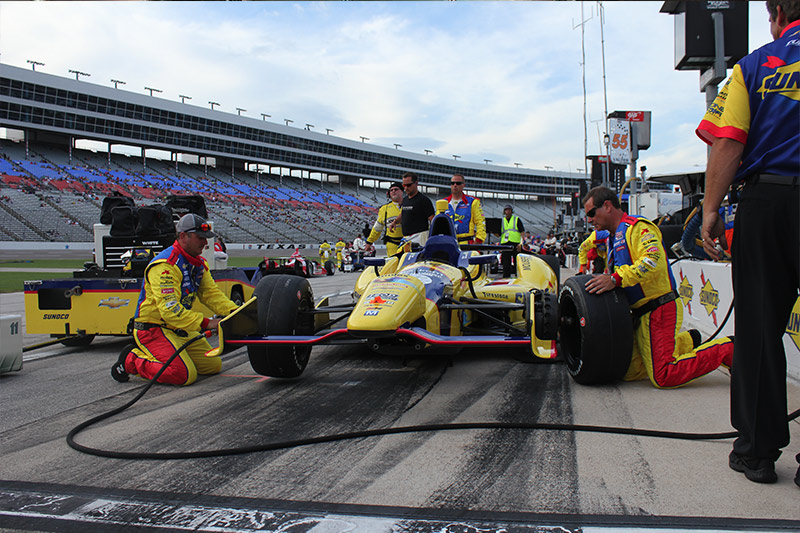Last week we gave you a brief look at some of the things Mouser’s technical team learned from the Data Acquisition Engineers at KV Racing –Josh Fults and Matt Cummings. We know a lot about electronics and how the Indy race team uses them, but these experts really gave us a greater understanding of the in-depth operation of electronics in racing. Read on to find out the rest of what we learned…

– One of the many important details the race technicians have to monitor is the car’s fuel level. There are two ways to determine this: One, you can measure the volume of the fuel by the gallon. Or two, a more accurate and faster way to find the volume during the race is to weigh the fuel and then measure the temperature to calculate the amount of fuel left. The team uses immersible Fluke probes to take the fuel temperature readings which are needed for this process.
– Once the required amount of fuel is determined for a fill up, the information is sent to one of the pit crewmembers to complete the refill. The fueler’s helmet actually has a little circuit board in it with a row of lights to tell him exactly when to pull the fuel nozzle out of the tank. The KV Racing team uses BIVAR (previously Califia Lighting) LEDs in their helmets. They also use other BIVAR lights in the truck and above their work stations. The super bright LEDs provide excellent light for the engineers’ small electronics work, such as soldering and crimping parts together. Yet another place where LEDs are put to good use is in steering wheel projects. Here, LEDs are used to alert the driver when caution lights and other alarms come on; to be sure he or she doesn’t miss important signals on the track.

Another way that Mouser supports KV Racing is to generate greater technological impact for the outcome of the race team by holding Mouser engineering challenges. These competitions are intended to help the Mouser / KV Racing Technology Team solve some of their most intriguing challenges and get participants involved, giving them a chance to win some neat prizes and of course, recognition for their engineering prowess.
The current competition is the Mouser 500 Engineering Challenge, which includes two contests held during this summer’s race season. The first part of the challenge is to design a “Pit Stop Camera/Fuel Readout”—a camera mounted to the top of the fuel rig that can be turned on via a wired or wireless connection to the timing stand, along with a display to read the voltage of a 0-5V Gil level sensor mounted in the fuel rig that reads the fuel tank level. The top five great ideas for each challenge will be chosen by our panel of experts and reviewed by the Mouser/KV Racing Technology Team, and prizes include an iPad mini, an official Mouser Racing photo, and Mouser swag. More information and official rules can be found on the 2013 Challenge page.
Our technical team was excited to learn such interesting details about how KV Racing uses electronics from some of the many suppliers who sponsor the team. We definitely learned a lot, and are putting the knowledge to good use. As the Indy season continues, we look forward to seeing what great designs will come from our engineering challenges, and also, of course, to more wins from KV Racing!

#11 Tony Kanaan and the 2013 Mouser IndyCar winning the Indy 500

Suzanna Brooks joined Mouser Electronics in 2011 as a Technical Content Specialist and writes web content about the newest embedded and optoelectronic products available. Suzanna holds a Bachelor of Science degree from Embry-Riddle Aeronautical University and is a private pilot.
Advertisement





